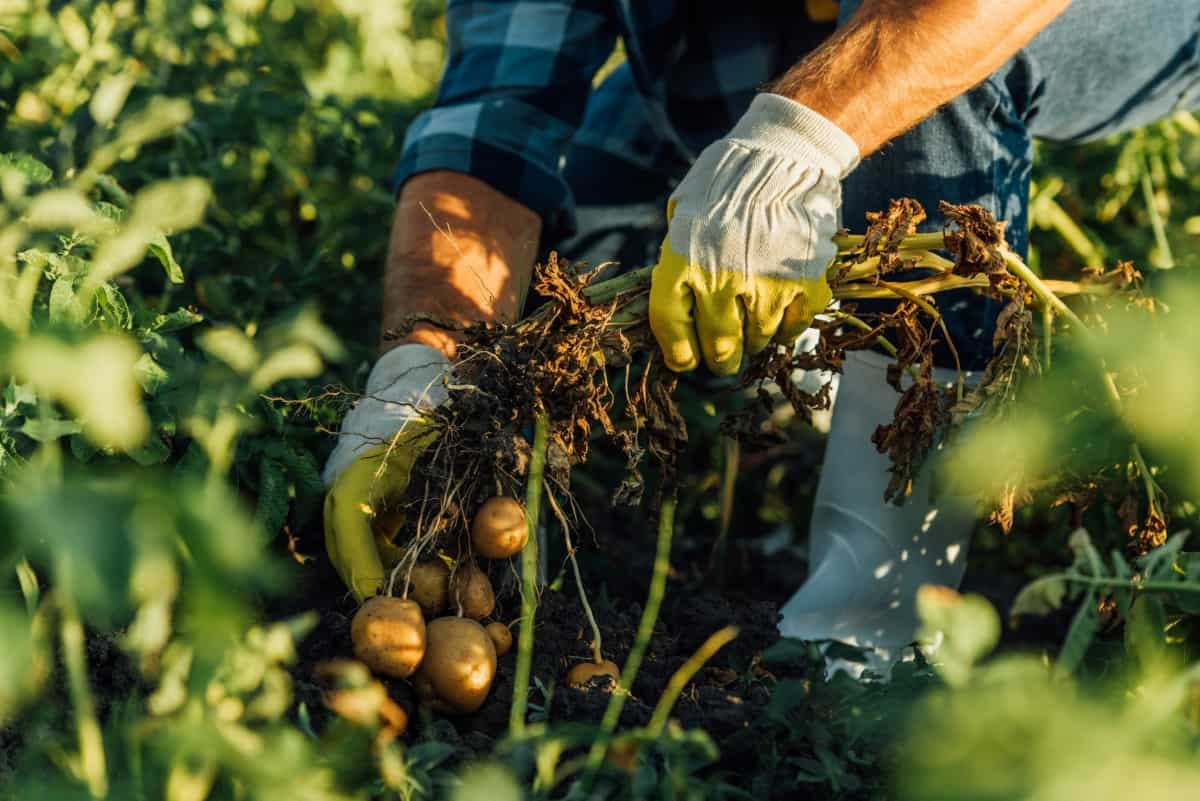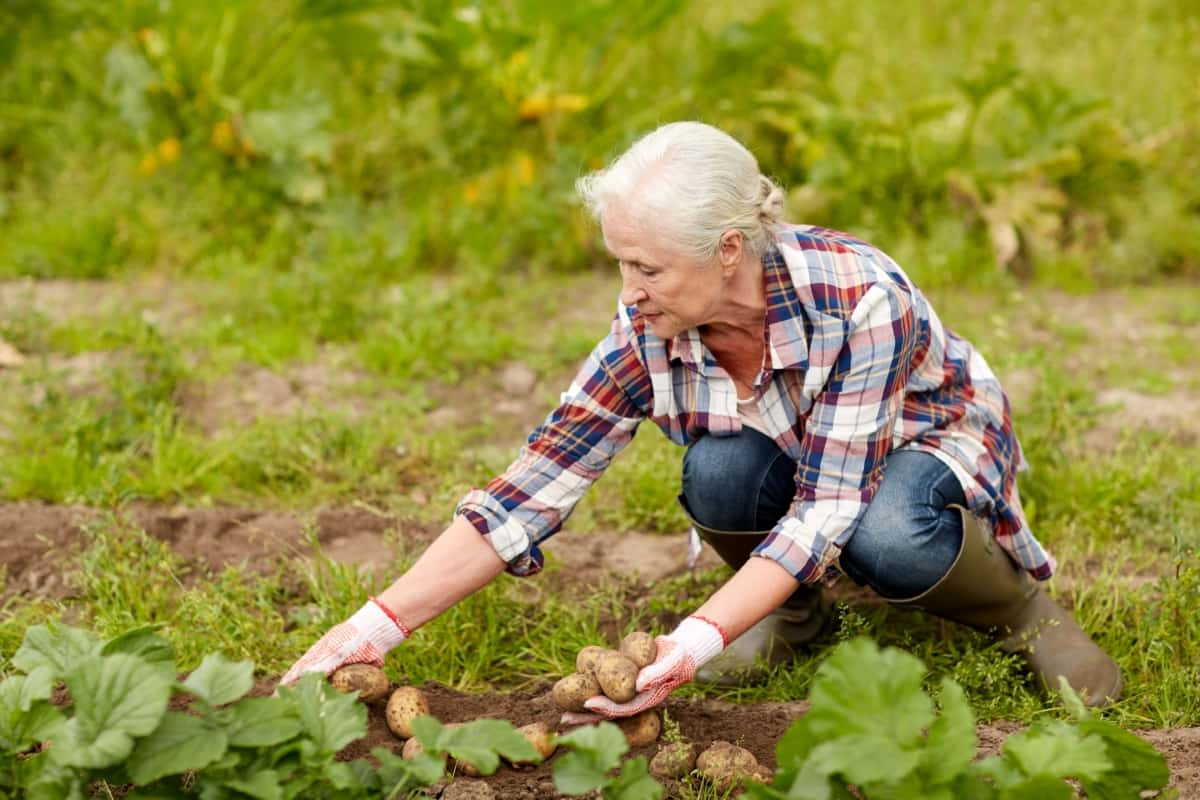Potato companion planting for increased yield is a method that cultivates different species of plants alongside potatoes to enhance their growth, productivity, and overall health. Farmers and gardeners can increase their potato yield organically and sustainably by leveraging the natural characteristics and relationships between certain plants. A technique rooted in permaculture and biodynamics, companion planting benefits crop yield and contributes to pest control, soil enhancement, and increased biodiversity.

Potato Companion Planting
Companion Planting and Intercropping Potatoes
Intercropping potatoes is growing two or more crops on the same land during a single growing season. This concept goes hand in hand with potato companion planting for increased yield. It reduces competition for nutrients, controls pests, and fully uses the available space. When intercropping potatoes, it’s important to consider each plant’s unique needs, growth habits, and compatibility with others.
For instance, potatoes, being root vegetables, require many nutrients, particularly phosphorus and potassium. Hence, the crops grown alongside them should ideally have different nutritional requirements or growth habits to prevent competition. Companion planting works best when each plant contributes something that benefits the others. Beans and peas make excellent partners for potatoes. They improve soil fertility by fixing nitrogen, a nutrient that potatoes don’t require in large amounts, thereby reducing competition for nutrients.
Moreover, the upright growth habit of beans and peas means they won’t compete with potatoes for space. Horseradish is another effective companion plant for potatoes. It reportedly improves the potatoes’ disease resistance and deters the Colorado potato beetle, a common pest. Planting it at the corners of the potato patch will provide an encompassing shield. Similarly, crops like marigolds and nasturtiums deter other pests and can be intercropped with potatoes for their protective properties.
What Not to Plant with Potatoes
Just as there are plants that benefit potatoes, there are others that are detrimental to their growth and should be avoided. Certain plants compete with potatoes for nutrients, encourage diseases, or attract pests, and hence, should not be planted alongside potatoes. Crops like carrots, celery, and parsnips are in the same family as the potato (the Apiaceae family) and are susceptible to similar pests and diseases. Intercropping these plants with potatoes increases the risk of shared pests or diseases spreading throughout the crop.
Similarly, crops like tomatoes, peppers, and eggplants are part of the Solanaceae family, just like potatoes. These plants share several pests and diseases, including blight, which can devastate crops. Planting these species together can lead to a quicker and more widespread infestation. Sunflowers are another plant to avoid as they inhibit potato growth. This is likely due to a process known as allelopathy, where certain plants release chemicals into the soil that are harmful to other plants.
Beneficial Potato Companion Plants
Aside from legumes and horseradish, several other plants benefit potatoes. Cabbage family plants can be beneficial companions, including broccoli, kale, and Brussels sprouts. These leafy vegetables provide ground cover, reducing weed competition and maintaining soil moisture levels, while their different nutritional needs and growth habits mean they won’t compete with potatoes for resources.
In case you missed it: Indeterminate vs. Determinate Potatoes: Which One Should You Plant?

Certain aromatic herbs are also useful in a potato patch. Plants like basil, coriander, and dill repel harmful insects while attracting beneficial ones. These herbs can help keep pest populations under control and may also enhance the flavor of the potatoes. Onions, garlic, and other alliums deter many pests that affect potatoes, such as aphids and wireworms, making them excellent companions. They are also less demanding of soil nutrients, leaving plenty for the potatoes.
Cover crops such as buckwheat and clover can also be beneficial when intercropped with potatoes. They help to suppress weeds, enhance soil health, and attract beneficial insects. Being a legume, Clover also improves soil nitrogen levels, which benefits subsequent crops if included in crop rotation schedules. Finally, flax is a beneficial companion for potatoes. Flax plants are known to repel the Colorado potato beetle, one of the potato’s most notorious pests. Also, the growth of flax is believed to improve the yield and overall quality of potatoes.
The Importance of Crop Rotation
One of the vital steps in potato companion planting for increased yield is the practice of crop rotation. Crop rotation involves strategically planting various kinds of crops in a given region over a series of growing seasons. This method lessens dependence on a single set of nutrients, mitigates issues related to pests and weeds, and minimizes the likelihood of pests and diseases developing resistance.
To rejuvenate soil nutrients, particularly nitrogen, it is beneficial to alternate the cultivation of potatoes with green manure crops such as clover and vetch. Additionally, introducing grains like corn or wheat into the rotation disrupts cycles of pests and diseases. The underlying principle is to avoid consecutively planting crops from the same family in a specific area.
Soil Preparation and Fertility
Preparing the soil adequately is another crucial step in ensuring a bountiful potato yield. Potatoes prefer well-draining, loose soil that’s slightly acidic, with a pH of around 5.8 to 6.5. Before planting, incorporate plenty of organic matter, like well-rotted compost or manure, to enhance soil fertility and structure. Regular soil testing can help you understand your soil’s needs better. If the soil lacks specific nutrients necessary for potatoes, such as potassium or phosphorus, you may need to amend the soil with a suitable organic fertilizer.
Proper Spacing and Planting
Spacing is important for healthy potato crops. If plants are too close, they will compete for resources and yield less. Normally, plant seed potatoes about a foot apart in rows 2 to 3 feet apart. However, adjust spacing based on the potato variety and its growth pattern. Plant potatoes after the last frost and when the soil is warm enough. While potatoes can tolerate light frost, their growth is best in warmer soil.
Pest and Disease Management
Regularly monitor your potato crop for signs of pests and diseases. Implementing organic pest control methods, like introducing beneficial insects, using traps or barriers, and applying natural insecticides, can help keep pest populations under control. For diseases, prevention is the best approach. Ensure your seed potatoes are disease-free, rotate your crops, and practice good sanitation by removing plant debris at the end of the season.
In case you missed it: How to Grow Potatoes in Greenhouse: A Step-by-Step Guide for Seed to Harvest

Conclusion
Potato companion planting for increased yield is a holistic, sustainable approach to agriculture and gardening that boosts the quantity and quality of your crops. This practice, grounded in generations of observation and experience, exploits the natural relationships and interactions between different plants. It fosters greater biodiversity, pest control, and soil health, contributing to a thriving, productive garden or field.
- Ultimate Guide to Ossabaw Island Hog: Breeding, Raising, Diet, and Care
- Ultimate Guide to Juliana Pig: Raising Facts, Size, Diet, Care, and Lifespan
- Raising Lleyn Sheep: Disadvantages, Price, Uses, Characteristics, and Care
- Ultimate Guide to Meishan Pig: Breed Facts, Breeding, Raising, and Care
- Ultimate Guide to Teacup Pigs: Raising, Diet, Lifespan, Cost, and Care
- Guide to Raising Poll Dorset Sheep: Facts, Profile, Characteristics, Uses, and Care
- Ultimate Guide to Bighorn Sheep: Characteristics, Diet, Lifespan, Breeding, and Lifecycle
- Ultimate Guide to Raising Katahdin Sheep: Farming Facts, Breed Profile, Uses, and Care
- Ultimate Guide to Raising Oreo Cows: Belted Galloways Farming Facts, Profile, Uses, and Care